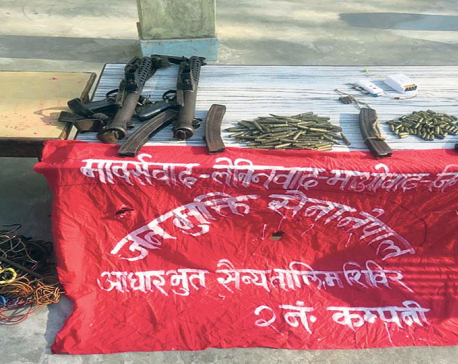
OR
World Wildlife Day: Wild buffaloes in country's only wildlife reserve in crisis due to domestic cattle
Published On: March 3, 2020 01:57 PM NPT By: RSS
ITAHARI, March 3: The world is celebrating the World Wildlife Day today with the slogan of ''Sustaining all life on earth''. Nepal's only wildlife reserve, the Koshi Tappu Wildlife Reserve (KTWR), of eastern tropical plains is having a hard time sustaining its indigenous wild water buffaloes.
Since the first-ever wild water buffalo census was conducted during its establishment in 1976, they numbered 63. Based on the latest three-yearly census of 2018, the total population of this native wild buffaloes of the Indian subcontinent stands at 441.
Despite an exciting growth, domesticated animals like cattle and buffaloes are troubling this wild animal identified by its scientific name Bubulus Arnee. ''There are chances of mistaking domesticated buffaloes as wild water buffaloes in our reserve,'' said Subhash Bhujel, a licensed nature guide who works in the reserve. Bhujel added, ''Domesticated buffaloes are mixing up with wild water buffaloes and tourists are unhappy with this.''
Bhujel said some locals are deliberately putting their domesticated buffaloes in the reserve for cross-breeding. ''It is believed that calves of domesticated buffaloes are better when they are born after mating with wild water buffaloes,'' informed Bhujel. He said the quality and volume of milk is also believed to increase after cross-breeding.
A chief conservation officer of the reserve Ramdev Chaudhary echoes similar sentiments. He said rare wild water buffaloes were facing an existential crisis. ''There is an imminent challenge of genetic swapping because of an increasing mix of domesticated buffaloes with wild water buffaloes in our reserve.'' Chaudhary, with 32 years of experience in wildlife conservation, said wild water buffaloes of KTWR were faced with many problems.
''The grazing space of wild water buffaloes are occupied by domesticated cattle and buffaloes as well as their habitat is diminished putting challenges to further growth of their numbers,'' deplored Chaudhary.
Chief conservation officer Chaudhary said he was facing legal hurdles to permanently remove illegally grazing cattle and buffaloes in the reserve. ''We captured domesticated cattle and buffaloes and put into our cattle panel. However, we can't auction due to legal reasons. Because of this, locals are reluctant to abide by KTWR rules and regulations," stated Chaudhary.
Area expansion, translocation, awareness key to preservation
KTWR is only a wildlife reserve in Nepal having a strong sanctuary for wild water buffaloes. Categorized by International Union for Conservation of Nature and Natural Resources (IUCN) as endangered species since 1986, wild water buffaloes of KTWR can be sustainably preserved by devising some five practical efforts, said Chaudhary.
The first one, according to Chaudhary, is to expand the area of KTWR from its present area of 175 square kilometers to more in its open spaces on the northern side for greater dwelling areas. ''KTWR can be upgraded as National Park if we are to expand the area towards suitable areas on the northern side around SrilankaTappu,'' he suggested.
Secondly, translocation is a method of sustaining wild water buffaloes, said Chaudhary. KTWR has translocated a dozen of wild buffaloes in Chitwan National Park in 2017. ''Translocation is necessary for rare species as this will not decrease its number even in case of a calamity in the only sanctuary."
The third effort to preserve KTWR always as a sanctuary for growing numbers of wild water buffaloes, Chaudhary said, was to introduce the legal provision of an auction for illegally found cattle in its vicinities.
The fourth idea is inspiring and empowering locals for stall-feeding of their cattle. ''Stall- feeding can drastically make low or no entry of domesticated cattle and buffaloes in our reserve,'' he suggested.
The most important way to preserve wild water buffalo is to generate awareness among locals, asserted Chaudhary. ''In this area, there is a belief in Yadav community that their wealth and social status is determined by the number of cattle and buffaloes,'' said Chaudhary, adding that this practice must be stopped.
The chief conservation officer said instead of counting numbers, quality must be emphasized through massive awareness campaigns to locals by local, provincial and federal governments. ''We can help them by distributing quality buffaloes with high-end meat and milk value.''
You May Like This

UML leader Basnet to Balen: Don't be pampered just because you have a few hundred fans on Facebook
KATHMANDU, August 26: While the Mayor of Kathmandu Metropolitan City (KMC), Balendra Shah, is speeding up the work to demolish... Read More...

Smugglers’ go-downs near customs office
SIRAHA, March 16: On March 10, a team from the District Police Office (DPO), Siraha, arrested a truck with an... Read More...

Govt restricts Chand group’s activities
KATHMANDU, March 13: The government on Tuesday outlawed the ‘political activities’ of the semi-underground Communist Party of Nepal led by... Read More...




Just In
- Govt receives 1,658 proposals for startup loans; Minimum of 50 points required for eligibility
- Unified Socialist leader Sodari appointed Sudurpaschim CM
- One Nepali dies in UAE flood
- Madhesh Province CM Yadav expands cabinet
- 12-hour OPD service at Damauli Hospital from Thursday
- Lawmaker Dr Sharma provides Rs 2 million to children's hospital
- BFIs' lending to private sector increases by only 4.3 percent to Rs 5.087 trillion in first eight months of current FY
- NEPSE nosedives 19.56 points; daily turnover falls to Rs 2.09 billion















Leave A Comment